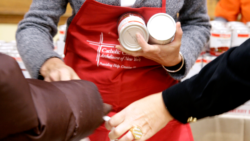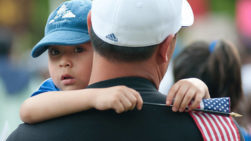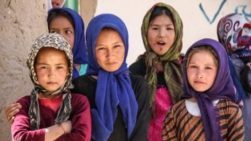In pandemic’s grip, concerns about food insecurity are compounded for older Americans.
Until March, Gabriel and Constancia Merrill had both worked to provide food to seniors, she preparing the meals and he delivering them.
But now, the couple has found themselves on the receiving end of food assistance after losing those jobs.
“We’ve never gone to a food bank before,” Mr. Merrill, 71, said. “Now, we’re to the point where we can’t do anything. We never thought we would be in this situation at all.”
Since their employer had to let them go in March because of curbed operations, the couple has survived off Social Security checks, and has yet to receive unemployment.
To make ends meet, the Merrills have been visiting Adventist Community Services of Greater Washington, a pantry working with Capital Area Food Bank, a member of the Feeding America network.
The Merrills are not alone. Before the coronavirus pandemic, more than 37 million Americans were considered food insecure by the government. A recent study from Feeding America projects that the number will rise significantly this year, as the coronavirus wreaks havoc on the most vulnerable populations’ livelihoods.
“Our demand has skyrocketed,” said Radha Muthiah, the president and chief executive of the Capital Area Food Bank, one of 200 in the network of Feeding America, a beneficiary agency of The New York Times Neediest Cases Fund. “We’re now looking to serve just over 600,000 people, as opposed to the 400,000 that we were projecting before Covid.”
Some seniors, Ms. Muthiah said, found themselves facing struggles before the pandemic began, such as being on a fixed income, rising rents or being full-time caretakers to their grandchildren. Now, with many staying home as much as possible because of an increased risk of hospitalization from the virus, those around 60 and older are facing new hardships. Just venturing to the grocery store or a food bank could now be hazardous for them.
In fact, Ms. Merrill, 62, recently tested positive for the coronavirus. She said she had been leaving the house only to get groceries and had experienced a mild case.
In order to mitigate this risk, food banks, like the Capital Area Food Bank, and groups like Catholic Charities Community Services have had to adjust their operations, some shifting to at-home delivery to ensure older people who either don’t want to or are unable to leave their homes continue to have enough food on their tables.
“For a lot of these seniors, this program is kind of their lifeline,” said Beatriz Diaz Taveras, executive director of Catholic Charities Community Services, which is part of Catholic Charities Archdiocese of New York, another beneficiary agency of The Fund. “We are doing as much as we can, but the need is greater than our resources.”
Catholic Charities Community Services used $6,000 from The Fund for July’s monthly food pantry bag expenses. The group has long offered at-home delivery through its Homebound Program, and demand surged after the pandemic began.
Having served about 60 people on a monthly basis before the pandemic, the Homebound initiative now delivers food to around 300 people each month.
Among them is Manuel Rosario, who is 85 and goes by Manny. Mr. Rosario volunteered at a Catholic Charities food bank for 20 years before becoming a recipient. Now, he is living with his two daughters in Harlem, mostly staying home as a precaution and recovering from knee surgery.
“Thank God, I’m OK,” Mr. Rosario said. “I feel good.”
Though Mr. Rosario’s favorite dish, rice with beans and chicken, was cooked by his late wife, Francisca (or Paquita, as he fondly called her), he says he is well-fed and grateful. And although Catholic Charities performs daily wellness calls to recipients like Mr. Rosario, he said he still misses talking with the people he once helped as a volunteer himself.
“They were good people,” he said.
Leaders at the Capital Area Food Bank and Catholic Charities project that food insecurity is likely to increase as the year goes on.
Hilary Salmon, a representative of the food bank, said her group estimates food insecurity could rise 50 to 60 percent this year in its region, which boasts some of the wealthiest counties in the country.
“You think, ‘Oh my goodness, this shouldn’t be happening in the capital of the wealthiest country on earth,’” Ms. Muthiah said “There’s obviously a lot that we, as food banks, are stretching to do and to respond during this pandemic, but we can’t do it alone.”
This article is used with permission from The New York Times Company.












